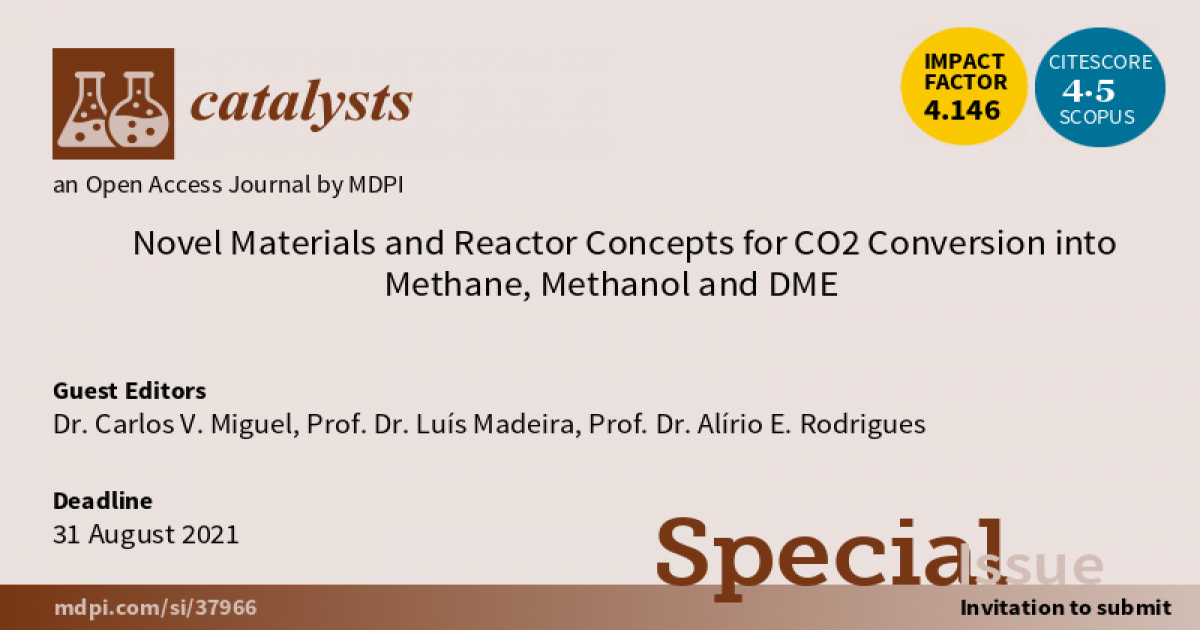Novel Materials and Reactor Concepts for CO2 Conversion into Methane, Methanol and DME
A special issue of Catalysts (ISSN 2073-4344). This special issue belongs to the section "Environmental Catalysis".
Deadline for manuscript submissions: closed (31 August 2021) | Viewed by 8357

Special Issue Editors
Interests: CO2 capture & utilization; multifunctional reactors; heterogeneous catalysis; membrane and adsorption separation processes; modeling and simulation of chemical reactors
Interests: multifunctional reactors; membrane reactors; hybrid adsorption–reaction processes; CO2 capture and valorization; H2 production and purification
Special Issues, Collections and Topics in MDPI journals
Interests: chemical engineering; bioengineering; materials engineering
Special Issues, Collections and Topics in MDPI journals
Special Issue Information
Dear Colleagues,
The present Special Issue focuses on CO2 utilization towards the production of methane, methanol, and DME, which can be used for energy production and as intermediates for obtaining other important chemicals. However, such CO2 conversion processes have associated energy and thermodynamic barriers that can be overcome through the development of new catalysts and reactor concepts. Hence, we encourage the submission of manuscripts related to the conversion of CO2 into these chemicals and covering the following topics:
- Catalyst development, screening, and deactivation tests;
- Development of non-conventional catalysts (e.g., dual-function materials, structured catalysts, etc.);
- Multifunctional reactor concepts (e.g., membrane, sorption-enhanced, etc.);
- Determination of reaction kinetics and mechanisms;
- Modeling (lab, pilot, and industrial scale reactors and phenomena at a particle scale).
Dr. Carlos V. Miguel
Prof. Dr. Luís Madeira
Prof. Alírio E. Rodrigues
Guest Editors
Manuscript Submission Information
Manuscripts should be submitted online at www.mdpi.com by registering and logging in to this website. Once you are registered, click here to go to the submission form. Manuscripts can be submitted until the deadline. All submissions that pass pre-check are peer-reviewed. Accepted papers will be published continuously in the journal (as soon as accepted) and will be listed together on the special issue website. Research articles, review articles as well as short communications are invited. For planned papers, a title and short abstract (about 100 words) can be sent to the Editorial Office for announcement on this website.
Submitted manuscripts should not have been published previously, nor be under consideration for publication elsewhere (except conference proceedings papers). All manuscripts are thoroughly refereed through a single-blind peer-review process. A guide for authors and other relevant information for submission of manuscripts is available on the Instructions for Authors page. Catalysts is an international peer-reviewed open access monthly journal published by MDPI.
Please visit the Instructions for Authors page before submitting a manuscript. The Article Processing Charge (APC) for publication in this open access journal is 2200 CHF (Swiss Francs). Submitted papers should be well formatted and use good English. Authors may use MDPI's English editing service prior to publication or during author revisions.
Keywords
- CO2 conversion
- heterogeneous catalysis
- multifunctional catalysts and reactors
- reaction kinetics
- modeling and simulation
- methane
- methanol
- DME
Benefits of Publishing in a Special Issue
- Ease of navigation: Grouping papers by topic helps scholars navigate broad scope journals more efficiently.
- Greater discoverability: Special Issues support the reach and impact of scientific research. Articles in Special Issues are more discoverable and cited more frequently.
- Expansion of research network: Special Issues facilitate connections among authors, fostering scientific collaborations.
- External promotion: Articles in Special Issues are often promoted through the journal's social media, increasing their visibility.
- Reprint: MDPI Books provides the opportunity to republish successful Special Issues in book format, both online and in print.
Further information on MDPI's Special Issue policies can be found here.







